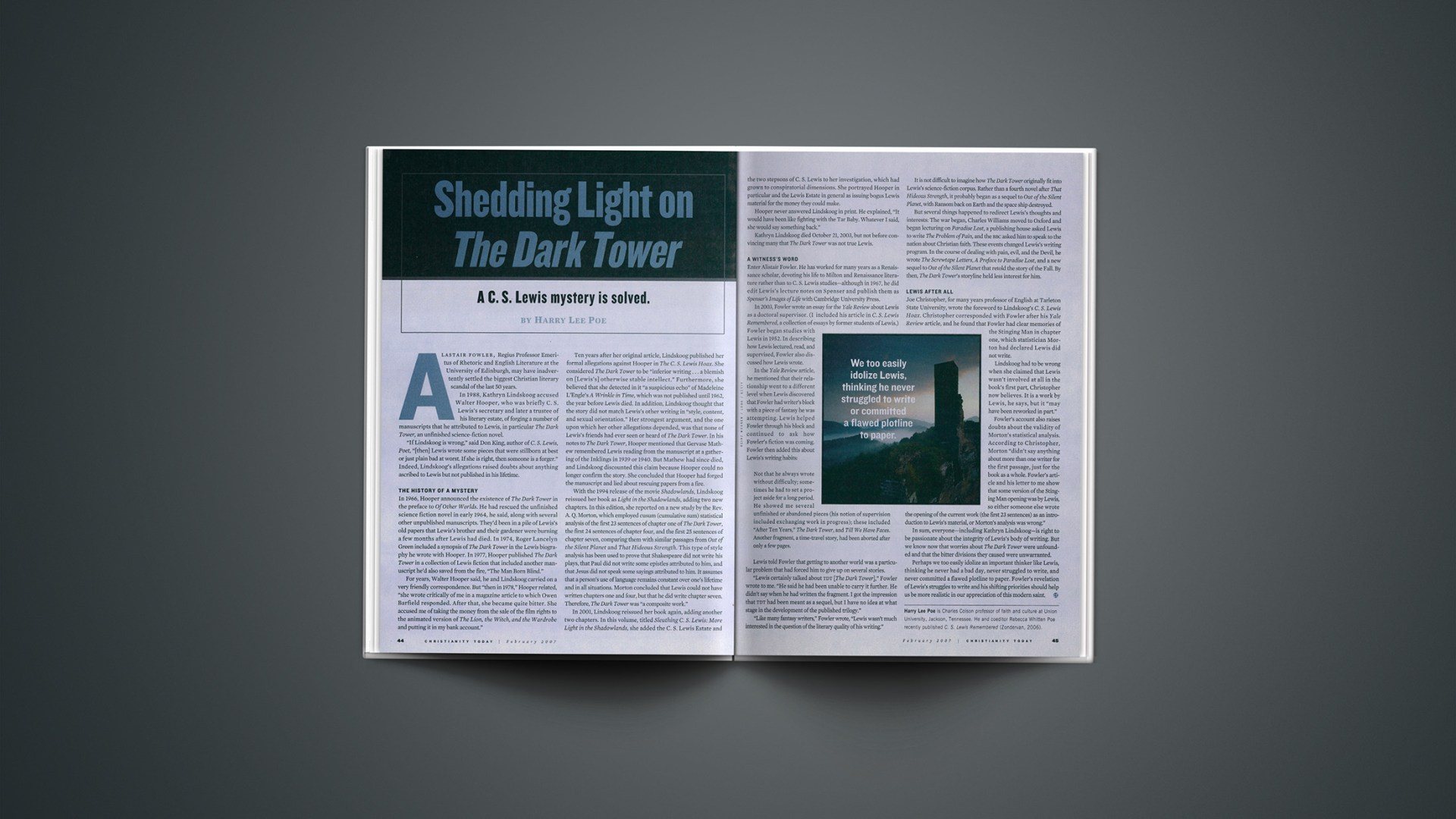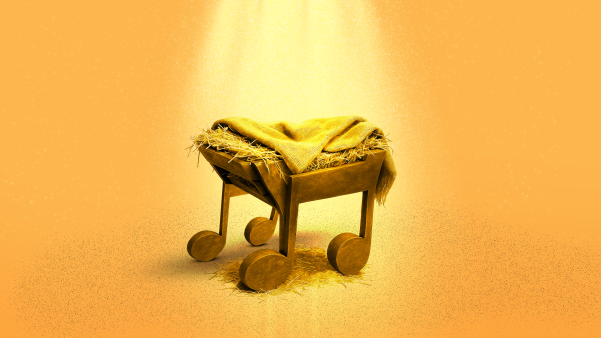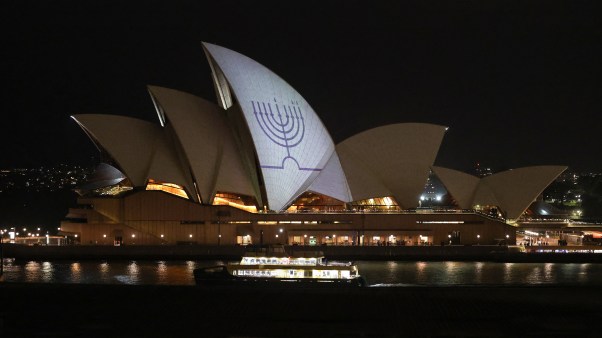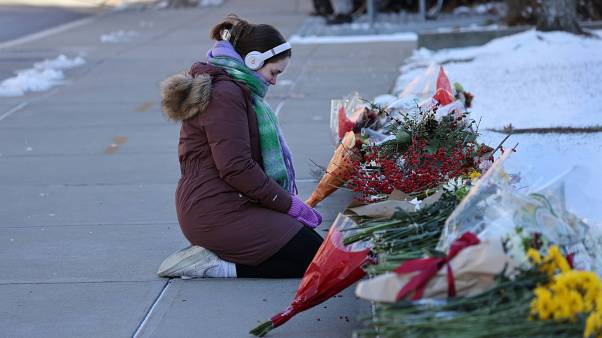Alastair Fowler, Regius Professor Emeritus of Rhetoric and English Literature at the University of Edinburgh, may have inadvertently settled the biggest Christian literary scandal of the last 50 years.
In 1988, Kathryn Lindskoog accused Walter Hooper, who was briefly C. S. Lewis’s secretary and later a trustee of his literary estate, of forging a number of manuscripts that he attributed to Lewis, in particular The Dark Tower, an unfinished science-fiction novel.
“If Lindskoog is wrong,” said Don King, author of C. S. Lewis, Poet, “[then] Lewis wrote some pieces that were stillborn at best or just plain bad at worst. If she is right, then someone is a forger.” Indeed, Lindskoog’s allegations raised doubts about anything ascribed to Lewis but not published in his lifetime.
The History of a Mystery
In 1966, Hooper announced the existence of The Dark Tower in the preface to Of Other Worlds. He had rescued the unfinished science fiction novel in early 1964, he said, along with several other unpublished manuscripts. They’d been in a pile of Lewis’s old papers that Lewis’s brother and their gardener were burning a few months after Lewis had died. In 1974, Roger Lancelyn Green included a synopsis of The Dark Tower in the Lewis biography he wrote with Hooper. In 1977, Hooper published The Dark Tower in a collection of Lewis fiction that included another manuscript he’d also saved from the fire, “The Man Born Blind.”
For years, Walter Hooper said, he and Lindskoog carried on a very friendly correspondence. But “then in 1978,” Hooper related, “she wrote critically of me in a magazine article to which Owen Barfield responded. After that, she became quite bitter. She accused me of taking the money from the sale of the film rights to the animated version of The Lion, the Witch, and the Wardrobe and putting it in my bank account.”
Ten years after her original article, Lindskoog published her formal allegations against Hooper in The C. S. Lewis Hoax. She considered The Dark Tower to be “inferior writing … a blemish on [Lewis’s] otherwise stable intellect.” Furthermore, she believed that she detected in it “a suspicious echo” of Madeleine L’Engle’s A Wrinkle in Time, which was not published until 1962, the year before Lewis died. In addition, Lindskoog thought that the story did not match Lewis’s other writing in “style, content, and sexual orientation.” Her strongest argument, and the one upon which her other allegations depended, was that none of Lewis’s friends had ever seen or heard of The Dark Tower. In his notes to The Dark Tower, Hooper mentioned that Gervase Mathew remembered Lewis reading from the manuscript at a gathering of the Inklings in 1939 or 1940. But Mathew had since died, and Lindskoog discounted this claim because Hooper could no longer confirm the story. She concluded that Hooper had forged the manuscript and lied about rescuing papers from a fire.
With the 1994 release of the movie Shadowlands, Lindskoog reissued her book as Light in the Shadowlands, adding two new chapters. In this edition, she reported on a new study by the Rev. A. Q. Morton, which employed cusum (cumulative sum) statistical analysis of the first 23 sentences of chapter one of The Dark Tower, the first 24 sentences of chapter four, and the first 25 sentences of chapter seven, comparing them with similar passages from Out of the Silent Planet and That Hideous Strength. This type of style analysis has been used to prove that Shakespeare did not write his plays, that Paul did not write some epistles attributed to him, and that Jesus did not speak some sayings attributed to him. It assumes that a person’s use of language remains constant over one’s lifetime and in all situations. Morton concluded that Lewis could not have written chapters one and four, but that he did write chapter seven. Therefore, The Dark Tower was “a composite work.”
In 2001, Lindskoog reissued her book again, adding another two chapters. In this volume, titled Sleuthing C. S. Lewis: More Light in the Shadowlands, she added the C. S. Lewis Estate and the two stepsons of C. S. Lewis to her investigation, which had grown to conspiratorial dimensions. She portrayed Hooper in particular and the Lewis Estate in general as issuing bogus Lewis material for the money they could make.
Hooper never answered Lindskoog in print. He explained, “It would have been like fighting with the Tar Baby. Whatever I said, she would say something back.”
Kathryn Lindskoog died October 21, 2003, but not before convincing many that The Dark Tower was not true Lewis.
A Witness’s Word
Enter Alistair Fowler. He has worked for many years as a Renaissance scholar, devoting his life to Milton and Renaissance literature rather than to C. S. Lewis studies—although in 1967, he did edit Lewis’s lecture notes on Spenser and publish them as Spenser’s Images of Life with Cambridge University Press.
In 2003, Fowler wrote an essay for the Yale Review about Lewis as a doctoral supervisor. (I included his article in C. S. Lewis Remembered, a collection of essays by former students of Lewis.) Fowler began studies with Lewis in 1952. In describing how Lewis lectured, read, and supervised, Fowler also discussed how Lewis wrote.
In the Yale Review article, he mentioned that their relationship went to a different level when Lewis discovered that Fowler had writer’s block with a piece of fantasy he was attempting. Lewis helped Fowler through his block and continued to ask how Fowler’s fiction was coming. Fowler then added this about Lewis’s writing habits:
Not that he always wrote without difficulty; sometimes he had to set a project aside for a long period. He showed me several unfinished or abandoned pieces (his notion of supervision included exchanging work in progress); these included “After Ten Years,” The Dark Tower, and Till We Have Faces. Another fragment, a time-travel story, had been aborted after only a few pages.
Lewis told Fowler that getting to another world was a particular problem that had forced him to give up on several stories.
“Lewis certainly talked about TDT [The Dark Tower],” Fowler wrote to me. “He said he had been unable to carry it further. He didn’t say when he had written the fragment. I got the impression that tdt had been meant as a sequel, but I have no idea at what stage in the development of the published trilogy.”
“Like many fantasy writers,” Fowler wrote, “Lewis wasn’t much interested in the question of the literary quality of his writing.”
It is not difficult to imagine how The Dark Tower originally fit into Lewis’s science-fiction corpus. Rather than a fourth novel after That Hideous Strength, it probably began as a sequel to Out of the Silent Planet, with Ransom back on Earth and the space ship destroyed.
But several things happened to redirect Lewis’s thoughts and interests: The war began, Charles Williams moved to Oxford and began lecturing on Paradise Lost, a publishing house asked Lewis to write The Problem of Pain, and the bbc asked him to speak to the nation about Christian faith. These events changed Lewis’s writing program. In the course of dealing with pain, evil, and the Devil, he wrote The Screwtape Letters, A Preface to Paradise Lost, and a new sequel to Out of the Silent Planet that retold the story of the Fall. By then, The Dark Tower‘s storyline held less interest for him.
Lewis After All
Joe Christopher, for many years professor of English at Tarleton State University, wrote the foreword to Lindskoog’s C. S. Lewis Hoax. Christopher corresponded with Fowler after his Yale Review article, and he found that Fowler had clear memories of the Stinging Man in chapter one, which statistician Morton had declared Lewis did not write.
Lindskoog had to be wrong when she claimed that Lewis wasn’t involved at all in the book’s first part, Christopher now believes. It is a work by Lewis, he says, but it “may have been reworked in part.”
Fowler’s account also raises doubts about the validity of Morton’s statistical analysis. According to Christopher, Morton “didn’t say anything about more than one writer for the first passage, just for the book as a whole. Fowler’s article and his letter to me show that some version of the Stinging Man opening was by Lewis, so either someone else wrote the opening of the current work (the first 23 sentences) as an introduction to Lewis’s material, or Morton’s analysis was wrong.”
In sum, everyone—including Kathryn Lindskoog—is right to be passionate about the integrity of Lewis’s body of writing. But we know now that worries about The Dark Tower were unfounded and that the bitter divisions they caused were unwarranted.
Perhaps we too easily idolize an important thinker like Lewis, thinking he never had a bad day, never struggled to write, and never committed a flawed plotline to paper. Fowler’s revelation of Lewis’s struggles to write and his shifting priorities should help us be more realistic in our appreciation of this modern saint.
Harry Lee Poe is Charles Colson professor of faith and culture at Union University, Jackson, Tennessee. He and coeditor Rebecca Whitten Poe recently published C. S. Lewis Remembered (Zondervan, 2006).
Copyright © 2007 Christianity Today. Click for reprint information.
Related Elsewhere:
Christian History & Biography’s has two issues on C.S.Lewis (1985 and 2005), who was also one of their ten most influential Christians of the 20th century.
C.S. Lewis Superstar, the cover article for Christianity Today‘s December 2005 issue, focuses on Lewis’ literary career and influence.
Kathryn Lindskoog published her website before her death (2003); it has many of her articles on Lewis.
Other articles that talk about the The Dark Tower controversy include:
C.S. Lewis: Mere Marketing? | Publisher, estate under fire for handling of C. S. Lewis’s identity. (August 6, 2001)
Weblog: The War for C.S. Lewis: The Prequel | Gabriel’s blessing for the Guthrie family (July 1, 2001)
The Dark Tower, Sleuthing C.S. Lewis: More Light in the Shadowlands,and C. S. Lewis Remembered: Collected Reflections of Students, Friends, & Colleagues (edited by Harry Lee Poe, contains Alastair Fowler’s essay on The Dark Tower) are available from ChristianBook.com and other retailers.









